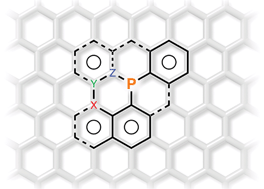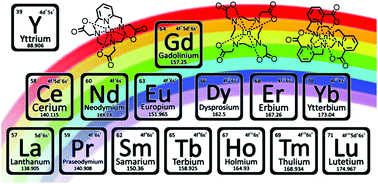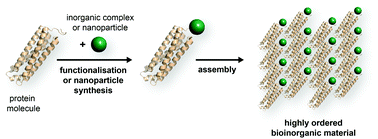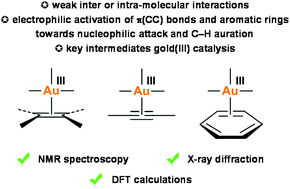Themed collection New Talent: Europe

New Talent: Europe, 2018
Welcome to this themed issue of Dalton Transactions entitled New Talent: Europe, 2018 guest edited by Richard A. Layfield, Marinella Mazzanti, Nils Metzler-Nolte and Sascha Ott.

Dalton Trans., 2018,47, 10319-10319
https://doi.org/10.1039/C8DT90116C
Highlights on π-systems based on six-membered phosphorus heterocycles
Herein, we highlight relevant π-systems based on six-membered phosphorus heterocycles as well as their potential in bio- and optoelectronic applications.

Dalton Trans., 2018,47, 10344-10359
https://doi.org/10.1039/C8DT01485J
Why develop photoactivated chemotherapy?
Some inorganic compounds kill cancer cells upon light irradiation without a need for dioxygen to be present. To which clinical needs could these compounds respond?

Dalton Trans., 2018,47, 10330-10343
https://doi.org/10.1039/C8DT01585F
Composed in the f-block: solution structure and function of kinetically inert lanthanide(III) complexes
An induction to the wonders of lanthanides, and a call for standardised methods for characterisation of lanthanide complexes in solution.

Dalton Trans., 2018,47, 10360-10376
https://doi.org/10.1039/C8DT01501E
Dinitrogen photoactivation: status quo and future perspectives
New perspectives for dinitrogen activation: an overview of photochemical pathways to cleave the strong N–N bond.

Dalton Trans., 2018,47, 10320-10329
https://doi.org/10.1039/C8DT00418H
Crystalline protein scaffolds as a defined environment for the synthesis of bioinorganic materials
We discuss synthetic strategies and applications of highly ordered bioinorganic materials based on crystalline protein scaffolds.

Dalton Trans., 2018,47, 10382-10387
https://doi.org/10.1039/C8DT01192C
Gold(III) π complexes
Recent achievements in the preparation, characterization and reactivity of gold(III) complexes of alkenes, alkynes and arenes are presented and discussed.

Dalton Trans., 2018,47, 10388-10393
https://doi.org/10.1039/C8DT01457D
Push and pull: the potential role of boron in N2 activation
Recent developments in main group chemistry towards the activation and conversion of N2 have lead to the revelation that boron can greatly affect these processes.

Dalton Trans., 2018,47, 10377-10381
https://doi.org/10.1039/C8DT01168K
Exploring the scope of capacitance-assisted electrochemical carbon dioxide capture
Electrochemical carbon mineralisation is facilitated by the separation of the graphite and aluminium anode components.

Dalton Trans., 2018,47, 10447-10452
https://doi.org/10.1039/C8DT01783B
Stabilizing intramolecular cobalt–imidazole coordination with a remote methyl group in the backbone of a cofactor B12–protein model
This communication describes the stabilizing effect of a remote methyl group in the backbone of a cobalamin–protein mimic on intramolecular imidazole–cobalt coordination.

Dalton Trans., 2018,47, 10443-10446
https://doi.org/10.1039/C8DT01298A
Synthesis and properties of heterobimetallic rhodium complexes featuring LiI, CuI or ZnII as a Lewis acidic metalloligand
Coordination of Lewis acidic metalloligands LiI, CuI and ZnII shows a remarkable impact on the CO stretching band in heterobimetallic rhodium complexes.

Dalton Trans., 2018,47, 10439-10442
https://doi.org/10.1039/C8DT01267A
Lewis base complexes of sila[2]aluminocenophanes
Several new sila[2]aluminocenophane Lewis base complexes are described, which were synthesized directly from the corresponding sila[2]magnesocenophane and AlX3·base precursors by transmetalation.
![Graphical abstract: Lewis base complexes of sila[2]aluminocenophanes](/lv/Image/Get?imageInfo.ImageType=GA&imageInfo.ImageIdentifier.ManuscriptID=C8DT02491J&imageInfo.ImageIdentifier.Year=2018)
Dalton Trans., 2018,47, 10425-10428
https://doi.org/10.1039/C8DT02491J
On the alcoholysis of alkyl-aluminum(III) alkoxy-NHC derivatives: reactivity of the Al-carbene Lewis pair versus Al-alkyl
Alkyl-aluminum(III) derivatives supported by a bifunctional alkoxy-NHC ligand display unusual reactivity at the carbene, yielding imidazolium-aluminate zwitterions.

Dalton Trans., 2018,47, 10429-10433
https://doi.org/10.1039/C8DT01498A
Silk fibroin nanoparticles as biocompatible nanocarriers of a novel light-responsive CO-prodrug
Silk fibroin nanoparticles have been used as platforms of a new photoactive CO-prodrug leading to a hybrid material with enhanced CO-release.

Dalton Trans., 2018,47, 10434-10438
https://doi.org/10.1039/C8DT02125B
Fine-tuning polyoxometalate non-linear optical chromophores: a molecular electronic “Goldilocks” effect
An optimal combination of electron donor strength and electronic communication produces the best performing polyoxmetalate-based NLO chromophore to date.

Dalton Trans., 2018,47, 10415-10419
https://doi.org/10.1039/C8DT01491D
Crystalline, room-temperature stable phosphine–SO2 adducts: generation of sulfur monoxide from sulfur dioxide
Particularly basic phosphines form isolable Lewis base adducts with SO2 that readily release SO at room temperature driven by the formation of the corresponding phosphine oxides.

Dalton Trans., 2018,47, 10420-10424
https://doi.org/10.1039/C8DT01484A
Difuryl(supermesityl)borane: a versatile building block for extended π-conjugated materials
B-Doping of oligo(hetarene)s led to very robust, air-stable π-conjugated materials that are strong electron-acceptors and blue light emitters.

Dalton Trans., 2018,47, 10399-10403
https://doi.org/10.1039/C8DT01716F
Highly active aluminium catalysts for room temperature ring-opening polymerisation of rac-lactide
New aluminium catalysts for room temperature rac-lactide ROP.

Dalton Trans., 2018,47, 10410-10414
https://doi.org/10.1039/C8DT01526K
Reactivity studies of an imine-functionalised phosphaalkene; unusual electrostatic and supramolecular stabilisation of a σ2λ3-phosphorus motif via hydrogen bonding
Protonation with strong acids at an imine over addition to a phosphaalkene; resulting adducts display hydrogen bonding.

Dalton Trans., 2018,47, 10404-10409
https://doi.org/10.1039/C8DT01607K
Boron-based donor-spiro-acceptor compounds exhibiting thermally activated delayed fluorescence (TADF)
We present highly luminescent borylated 2-phenylpyridines, which exhibit tunable delayed fluorescence due to their donor-spiro-acceptor architecture.

Dalton Trans., 2018,47, 10394-10398
https://doi.org/10.1039/C8DT01255E
Impact of the lanthanide contraction on the activity of a lanthanide-dependent methanol dehydrogenase – a kinetic and DFT study
Lanthanide-dependent methanol dehydrogenases show highest activity with early lanthanides.

Dalton Trans., 2018,47, 10463-10472
https://doi.org/10.1039/C8DT01238E
Covalently linking CuInS2 quantum dots with a Re catalyst by click reaction for photocatalytic CO2 reduction
Covalently linking a Re catalyst to CuInS2 QDs through a facile click reaction for efficient electron transfer to improve photocatalytic CO2 reduction is reported.

Dalton Trans., 2018,47, 10775-10783
https://doi.org/10.1039/C8DT01631C
Monitoring surface transformations of metal carbodiimide water oxidation catalysts by operando XAS and Raman spectroscopy
Chemical and structural transformations at the electrode surface of metal carbodiimides MNCN (M = Co, Ni, Mn, Cu), were studied by operando Raman and XAS spectroscopy during electrocatalytic water oxidation

Dalton Trans., 2018,47, 10759-10766
https://doi.org/10.1039/C8DT01587B
pH dependent binding in de novo hetero bimetallic coiled coils
pH dependent metal binding to a designed hetero bimetallic coiled coil featuring a lanthanide binding site.

Dalton Trans., 2018,47, 10784-10790
https://doi.org/10.1039/C8DT01568F
Chiral Cu(II), Co(II) and Ni(II) complexes based on 2,2′-bipyridine modified peptoids
Helical peptoids bearing 2,2′-bipyridine, varied in their chiral bulky side chains and their N-terminus form chiral complexes with Cu(II), Co(II) and Ni(II) via intramolecular binding.

Dalton Trans., 2018,47, 10767-10774
https://doi.org/10.1039/C8DT01308J
Capacity fading mechanism of tin phosphide anodes in sodium-ion batteries
Tin phosphide (Sn4P3) is here investigated as an anode material in half-cell, symmetrical, and full-cell sodium-ion batteries.

Dalton Trans., 2018,47, 10752-10758
https://doi.org/10.1039/C8DT01068D
Coordination polymers built up from an s-tetrazine derived ligand and rare-earth ions: from a sequential dimensional expansion to organic–inorganic energy transfer
From 1D to 2D: the dimensionality of a coordination polymer based on a luminescent tetrazine and Tb3+ ions has been increased using a two step procedure.

Dalton Trans., 2018,47, 10715-10720
https://doi.org/10.1039/C8DT01268G
Seven-coordinate lanthanide complexes with a tripodal redox active ligand: structural, electrochemical and spectroscopic investigations
One-electron oxidation of the lanthanide complexes affords phenoxyl radical species. Radical formation is accompanied by a quenching of the metal-based luminescence.

Dalton Trans., 2018,47, 10742-10751
https://doi.org/10.1039/C8DT01165F
Monomeric Fe(III) half-sandwich complexes [Cp′FeX2] – synthesis, properties and electronic structure
Bis(alkyl)iron(III) half-sandwich complexes exhibit solvent dependent reactivity when treated with H2.
![Graphical abstract: Monomeric Fe(iii) half-sandwich complexes [Cp′FeX2] – synthesis, properties and electronic structure](/lv/Image/Get?imageInfo.ImageType=GA&imageInfo.ImageIdentifier.ManuscriptID=C8DT01570H&imageInfo.ImageIdentifier.Year=2018)
Dalton Trans., 2018,47, 10517-10526
https://doi.org/10.1039/C8DT01570H
An innovative and efficient route to the synthesis of metal-based glycoconjugates: proof-of-concept and potential applications
An innovative, facile and efficient synthetic route to the functionalization of metallodrugs with carbohydrates in high yields and purity is reported.

Dalton Trans., 2018,47, 10721-10736
https://doi.org/10.1039/C8DT01583J
Highly luminescent lanthanide complexes sensitised by tertiary amide-linked carbostyril antennae
The replacement of the secondary amide linker that carries the sensitizing carbostyril antenna with a tertiary amide in luminescent Eu and Tb complexes dramatically increases the lanthanide emission quantum yields.

Dalton Trans., 2018,47, 10702-10714
https://doi.org/10.1039/C8DT01270A
Electrochemical water oxidation using a copper complex
This study highlights the importance of proton coupled electron transfer (PCET) during electrochemical-driven water oxidation catalysis employing a copper complex.

Dalton Trans., 2018,47, 10737-10741
https://doi.org/10.1039/C8DT01323C
The modular synthesis of rare earth-transition metal heterobimetallic complexes utilizing a redox-active ligand
The redox-active bridging ligand 1,10-phenathroline-5,6-dione, acts as the template for this modular synthetic route to f–d heterobimetallic complexes.

Dalton Trans., 2018,47, 10692-10701
https://doi.org/10.1039/C8DT01262H
Coinage metal complexes of selenoureas derived from N-heterocyclic carbenes
The coordination chemistry of selenoureas derived from N-heterocyclic carbenes with copper and silver is explored, and compared to previous work with gold.

Dalton Trans., 2018,47, 10671-10684
https://doi.org/10.1039/C8DT01506F
A protocol for quantifying hydrogen evolution by dye-sensitized molecular photocathodes and its implementation for evaluating a new covalent architecture based on an optimized dye-catalyst dyad
Reproducible hydrogen measurements from molecular photocathodes were made by combining gas chromatography for headspace and a Clark-type electrode for solution.

Dalton Trans., 2018,47, 10509-10516
https://doi.org/10.1039/C8DT01210E
Viologen-modified electrodes for protection of hydrogenases from high potential inactivation while performing H2 oxidation at low overpotential
In this work we present a viologen-modified electrode providing protection for hydrogenases against high potential inactivation.

Dalton Trans., 2018,47, 10685-10691
https://doi.org/10.1039/C8DT00955D
Bicapped Keggin polyoxomolybdates: discrete species and experimental and theoretical investigations on the electronic delocalization in a chain compound
Monomeric and 1D reduced Keggin polyoxometalates have been isolated as black crystals soluble in DMSO; DFT calculations allowed the explanation of the magnetic behavior.

Dalton Trans., 2018,47, 10636-10645
https://doi.org/10.1039/C8DT01313F
Towards the rational design of the Py5-ligand framework for ruthenium-based water oxidation catalysts
An in–depth view on the water oxidation mechanism of Py5-derived Ru catalysts, paving the way for rational design of analogous water oxidation catalysts.

Dalton Trans., 2018,47, 10480-10490
https://doi.org/10.1039/C8DT01209A
Aggregated initiators: defining their role in the ROP of rac-lactide
Reported examples of aggregated initiators for the ring-opening polymerisation (ROP) of lactide often lack detailed investigations as to the nature of the active species, making it difficult to reconcile ligand design with performance.

Dalton Trans., 2018,47, 10626-10635
https://doi.org/10.1039/C8DT01229F
Supramolecular assemblies based on amphiphilic Mn2+-complexes as high relaxivity MRI probes
The Mn2+ complexes of amphiphilic derivatives of EDTA and 1,4-DO2A ligands show a strong increase in relaxivity upon micellar aggregation and human serum albumin binding.

Dalton Trans., 2018,47, 10660-10670
https://doi.org/10.1039/C8DT01250D
Selective CO2 adsorption by a new metal–organic framework: synergy between open metal sites and a charged imidazolinium backbone
A new metal–organic framework features a combination of open metal sites and charged ligand leading to a high CO2/N2 selectivity.

Dalton Trans., 2018,47, 10527-10535
https://doi.org/10.1039/C8DT01247D
Post-functionalization of a photoactive hybrid polyoxotungstate
A new approach to the development of photoactive hybrid polyoxometalates is reported, combining inorganic and organic functionalisation strategies.

Dalton Trans., 2018,47, 10590-10594
https://doi.org/10.1039/C8DT01253A
Preparation and characterisation of heterobimetallic copper–tungsten hydride complexes
The preparation and structural characterisation of three new heterobimetallic hydride complexes containing 3-centre,2-electron W–H–Cu bonds is reported.

Dalton Trans., 2018,47, 10595-10600
https://doi.org/10.1039/C8DT01569D
Peptide metal–organic frameworks under pressure: flexible linkers for cooperative compression
The peptidic linker in Zn(GlyTyr)2 provides a compressible cushion that allows for accommodating large distortions in the framework whilst avoiding amorphization.

Dalton Trans., 2018,47, 10654-10659
https://doi.org/10.1039/C8DT01765D
Amphiphilic complexes of Ho(III), Dy(III), Tb(III) and Eu(III) for optical and high field magnetic resonance imaging
Amphiphilic lanthanide(III) complexes self-assemble into monodisperse micelles with favourable properties for optical and high field magnetic resonance imaging.

Dalton Trans., 2018,47, 10646-10653
https://doi.org/10.1039/C8DT01227J
Heteroleptic samarium(III) halide complexes probed by fluorescence-detected L3-edge X-ray absorption spectroscopy
The novel series of heteroleptic Sm(III) halide complexes provides the backdrop for a fluorescence-detected Lα1 X-ray absorption spectroscopic study.

Dalton Trans., 2018,47, 10613-10625
https://doi.org/10.1039/C8DT01452C
Uranium(III) complexes supported by hydrobis(mercaptoimidazolyl)borates: synthesis and oxidation chemistry
[UIIII{κ3-H(R)B(timMe)2}2(thf)2] (R = H, Ph) complexes have been prepared by the salt ligand metathesis reaction with [UI3(thf)4]. Oxidation reactions of the uranium(III) complexes afforded the first structurally characterized U(IV) and U(VI) complexes supported by hydrobis(mercaptoimidazolyl)borates.

Dalton Trans., 2018,47, 10601-10612
https://doi.org/10.1039/C8DT01149D
Unravelling the spin-state of solvated [Fe(bpp)2]2+ spin-crossover complexes: structure–function relationship
Revealing the reasons why the lattice solvent stabilises one spin form over the other in [Fe(bpp)2]2+ complexes bearing anions with different charge/size ratios.
![Graphical abstract: Unravelling the spin-state of solvated [Fe(bpp)2]2+ spin-crossover complexes: structure–function relationship](/lv/Image/Get?imageInfo.ImageType=GA&imageInfo.ImageIdentifier.ManuscriptID=C8DT01269E&imageInfo.ImageIdentifier.Year=2018)
Dalton Trans., 2018,47, 10453-10462
https://doi.org/10.1039/C8DT01269E
Aminotroponiminates: ligand-centred, reversible redox events under oxidative conditions in sodium and bismuth complexes
Redox-active bismuth complexes based on a new aminotroponiminate ligand with ferrocenyl substituents have been synthesised and characterised.

Dalton Trans., 2018,47, 10578-10589
https://doi.org/10.1039/C8DT01019F
Copper(II)-benzotriazole coordination compounds in click chemistry: a diagnostic reactivity study
This diagnostic study aims to shed light on the catalytic activity of a library of Cu(II) based coordination compounds with benzotriazole-based ligands.

Dalton Trans., 2018,47, 10491-10508
https://doi.org/10.1039/C8DT01256C
Isolation of EPR spectra and estimation of spin-states in two-component mixtures of paramagnets
The isolation of component EPR spectra and identification of electron spin multiplicity is explored in an industrially relevant precatalyst system.

Dalton Trans., 2018,47, 10473-10479
https://doi.org/10.1039/C8DT00977E
Phosphorescent cationic iridium(III) complexes bearing a nonconjugated six-membered chelating ancillary ligand: a strategy for tuning the emission towards the blue
Blue and blue-green-emitting cationic Ir(III) complexes bearing a nonconjugated N^N ligand have been studied.

Dalton Trans., 2018,47, 10569-10577
https://doi.org/10.1039/C8DT00467F
Platinum(IV) azido complexes undergo copper-free click reactions with alkynes
We report our investigations into the first examples of copper-free 1,3-dipolar cycloaddition (click) reactions of electrophiles with a Pt(IV) azido complex.

Dalton Trans., 2018,47, 10553-10560
https://doi.org/10.1039/C7DT04183G
Reactant or reagent? Oxidation of H2 at electronically distinct nickel-thiolate sites [Ni2(μ-SR)2]+ and [Ni–SR]+
The chemical bond between a Lewis-acidic metal and a Brønsted/Lewis-basic sulphur donor provides M–S structures with functional properties that are relevant for a variety of processes such as the heterolytic cleavage of H2.
![Graphical abstract: Reactant or reagent? Oxidation of H2 at electronically distinct nickel-thiolate sites [Ni2(μ-SR)2]+ and [Ni–SR]+](/lv/Image/Get?imageInfo.ImageType=GA&imageInfo.ImageIdentifier.ManuscriptID=C8DT00275D&imageInfo.ImageIdentifier.Year=2018)
Dalton Trans., 2018,47, 10561-10568
https://doi.org/10.1039/C8DT00275D
Carbodiphosphorane-based nickel pincer complexes and their (de)protonated analogues: dimerisation, ligand tautomers and proton affinities
For a series of carbodiphosphorane-based Ni-pincer complexes, theoretical and experimental data is investigated and points towards carbodiphosphorane-based donor groups as potential proton relays in catalytic applications.

Dalton Trans., 2018,47, 10544-10552
https://doi.org/10.1039/C7DT04930G
Combining single source chemical vapour deposition precursors to explore the phase space of titanium oxynitride thin films
Combining single-source precursors in aerosol assisted CVD allows control of the composition of mixed anion titanium oxynitride thin films.

Dalton Trans., 2018,47, 10536-10543
https://doi.org/10.1039/C7DT04694D
About this collection
This themed issue ultimately aims to reflect the strength and vitality of European inorganic chemistry and is guest-edited by Professors Sascha Ott (Uppsala University, Sweden), Richard Layfield (University of Manchester, UK), Marinella Mazzanti (EPFL, Switzerland) and Nils Metzler-Nolte (Ruhr-Universität Bochum, Germany).